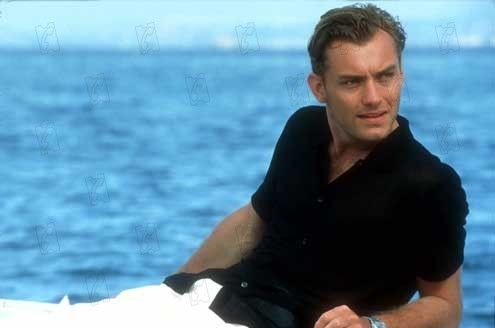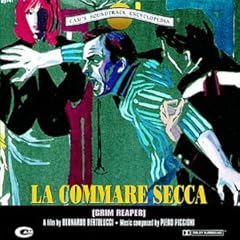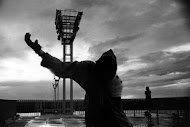When considering the capital-T Talented Mr. Ripley, I have to ask the big question first. Can Alain Delon out-sexy Jude Law?


That is a tough call my friends--Delon might get it because he spends more of his film with his shirt off. Of course, I'm comparing a Ripley to a Greenleaf here, but it's one of my favorite film hypotheticals to flip roles of Matt Damon and Law in The Talented Mr. Ripley. While Damon does a superb job as a man who murders in a momentary loss of control, Law is much more like Delon's Ripley: beautiful and vicious. I love Law playing a jovial game of bocce in his white loafers moments before giving Tom a raised-neck-vein dressing-down. If only there were enough creative juice in Hollywood to give Law the chance at Ripley (maybe in a few years, in one the sequels besides Ripley's Game, in my imaginary screening room).
The Talented Mr. Ripley and Plein Soleil both have excellent, color-saturated title sequences, and then diverge quite a lot, considering their identical source. PS jumps right into the action with Delon writing postcards in forged handwriting, while TMR meanders a bit through recital halls and flayed-hog alleys before Damon hits the beach in Mongibello in smashing neon lime swim trunks. From there, Minghella's film retreats into interior space--houses, hotel rooms, police stations. Even outside it is often cloudy, in shots of Rome and, especially, Venice. Watching PS we blister along with Delon's back as he's dragged behind Dickie's sailboat (named Marge in PS and Bird in TMR). He schemes under the sun, murders at noon, and is caught having an afternoon drink on the sunny patio.

It’s notable that Patricia Highsmith claims that Delon is her favorite Ripley—the most cold-blooded. I agree that he is the most Ripley, if not the best actor. Furthermore, Maurice Ronet is how I actually image Greenleaf being—he is far more physical than Law, truly loutish. (Delon and Ronet also met in another film under the sun, La Piscine. No, not the one with Ludivine Sagnier’s breasts--the one with Romy Schneider’s breasts. And, come to think of it, Ronet came up on the short end again there.) So how is it that I prefer TMR, since I just said both Ripley and Greenleaf are more accurate to the book in PS?

It's the supporting players and set pieces. Marie Laforet makes little impression as Marge (truly a great name--just listen to all the boys condescendingly purr "Marrrrge" in both films) and it’s impossible to overcome Phillip Seymour Hoffman as Freddy Miles (I like to think that Ripley really kills him because he dares question his interior decorating choices). I also appreciate the creation of Cate Blanchett’s character and the complications she adds to the plot. In TMR, we get the opera, the tense action on the Spanish Steps, the fabulous house in Venice where Ripley squeezes his razor a little too tight. PS is never as grounded in the continually evocative Italy of the 1950's, the locations I want to watch again and again.
PS also gets two important things wrong. The facts are: 1) Tom Ripley is gay. 2) Tom Ripley can never be caught! So a critical psychological undertone and the ending are manipulated. Could he not get away with homosexuality and murder onscreen in 1960? That's the only defense.
Onwards and upwards to a place that was much more surprisingly beautiful--the space and spaceships of the first two Alien films. Ridley Scott's Nostromo holds up very well; even though the video monitors and computer screens were probably the height of technology thirty years ago, their anachronistic look today reinforces the semi-forgotten feel of the crew's mission. Alien begins with the characters working their banal jobs and bitching constantly--it could be any working stiff's day to day. In fact, my favorite part of the film was the Office-style blunders by management that put the crew at risk.

Over and over in the films, we learn that if everyone just listened to Ripley, everything would be okay. She doesn't want to let the face-hugger through quarantine, she doesn't want anyone to go back to LV-426, she does want to blow up the whole damn planet of aliens rightnow, etc. It's a shame that James Cameron ruins her independent pragmatism with backstory about her dead daughter and the introduction of Newt. But he does get a gold star for giving us a future of fashion defined by all the managers wearing their suit collars flipped up.
Like the TMR/PS divide, Alien separates itself from Aliens with its supporting pieces. In the former: John Hurt, with that beautiful little monster springing from his chest, Ian Holm, as an actual robot(!), Tom Skerrit, looking like a captain but lacking the balls, Yaphet Kotto, chewing scenery, and Harry Dean Stanton, as the confused first man into the abyss. In Aliens...Bill Paxton is prominently involved. I did love the hot tamale Marine who litters our ears with oddly-accented “pendejos.”
The constant is Ripley, Sigourney Weaver. There’s something moving in her slow certainty (vocally and kinetically), her willingness to venture straight into the slick catacombs of the aliens. She's frightened but brave, more "real" than 95% of action heroes. Not to mention her continuing allegiance to wandering around in not-terribly-arousing space-age lingerie--there's a whiff of Target discount rack. Was this the height of sexiness in the 80’s? I don’t know, but I appreciate the strangeness of it today.
 In conclusion: all characters named Ripley are good for the cinema.
In conclusion: all characters named Ripley are good for the cinema.









